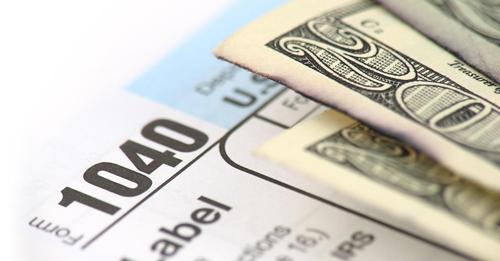Millions of U.S. taxpayers could receive a shock when they see their 2023 tax refunds due to the expiration of many pandemic benefits that lawmakers had designed to help Americans weather the crisis.
That means families may see smaller refunds when they file their taxes for the 2022 tax year, said Mark Steber, chief tax information officer at Jackson Hewitt. The average tax refund in 2022 (for the 2021 tax year) was almost $3,200, a 14% jump from the prior year, according to IRS data.
The IRS on Thursday said it will start accepting tax returns on January 23, while the filing deadline is April 18, giving taxpayers an extra three days beyond the typical April 15 deadline to file. That’s because April 15 falls on a Saturday, while Monday, April 17, is Emancipation Day in the District of Columbia.
The benefits that boosted refunds during the pandemic have largely lapsed, ranging from federal stimulus checks to the expanded Child Tax Credit (CTC), Steber noted. Even the IRS is warning taxpayers that checks may be stingier. The tax agency cautioned in a November news release: “Refunds may be smaller in 2023.”
Many of the tax benefits still exist, but under current tax law they have reverted to their smaller, pre-pandemic levels, such as in the case of the CTC, which is credited with lifting millions of children out of poverty. The CTC is reverting to its prior level of $2,000 per child, compared with a pandemic credit that was high as $3,600 per kid.
The year 2021 “was quite a remarkable year with the insertion of all those new tax breaks,” Steber noted. “But jump ahead to [2022], and a lot of the increases expired, hence the term ‘refund shock’ or ‘refund surprise.'”
The typical tax refund this year could be around $2,700, or roughly what taxpayers got in 2021 (for their 2020 taxes), Steber said. Of course, each taxpayer’s situation is different, with refunds dependent on a number of factors, ranging from an individual’s tax bracket to whether a taxpayer has children.
One rule of thumb recommended by Steber: Don’t look at your tax return from last year to determine what you’ll receive for your refund in 2023.
“You’re probably going to have not as pleasant an experience as you had last year,” he said.
The IRS is also warning taxpayers that they shouldn’t bank on getting their refunds “by a certain date, especially when making major purchases or paying bills.”
It added, “Some returns may require additional review and may take longer.”
Here are some of the tax changes that could impact your refund this year.
No stimulus check
The government did not issue any stimulus checks in 2022, with the third and final payment authorized in the spring of 2021 through the American Rescue Plan Act. Because these checks were paid in 2021, they were reflected in tax returns filed in early 2022 and affected tax refunds received earlier this year.
Some taxpayers relied on their 2021 tax filing to claim more stimulus money, which helped them get bigger refunds. For instance, children born in 2021 generally weren’t included in the third round of stimulus checks because the IRS was relying on 2020 tax returns to establish eligibility — and thus children born in 2021 were initially passed over by the tax agency. However, parents were able to claim the third stimulus check for these children when they filed their taxes last year.
A smaller Child Tax Credit
The Child Tax Credit got supercharged in 2021, with parents of children under 6 receiving $3,600 and parents of children ages 6 to 17 getting $3,000.
But in 2022, that tax credit reverted to its pre-pandemic level of $2,000 per child, regardless of age. While that’s certainly a help, that slimmer tax break could make an impact on parents’ refunds.
Some lawmakers and child advocates are pushing to reinstate the higher CTC amounts, with Representative Adam Schiff, a Democrat from California, in December urging congressional leaders to extend the expanded CTC. But with Congress now divided, with Republicans controlling the House, it’s unlikely that the benefit would be returned to its expanded form.
The Child and Dependent Care Tax Credit
The Child and Dependent Care Credit, which helps parents pay for child care, was boosted under the American Rescue Plan, which raised the credit to up to $8,000 per family.
But that tax credit has also reverted to its pre-pandemic level. Under the current law, parents can receive a credit on their 2022 taxes for up to 35% of up to $6,000 in qualifying child care expenses for two or more children.
That means the maximum credit is $2,100 for the current year. (The amount is halved for parents of one child.)
Earned Income Tax Credit
Another tax credit that is less generous for 2022 tax filers is the Earned Income Tax Credit, or EITC, which is aimed at low- and moderate-income workers.
During the pandemic, the EITC was increased for a group of workers who typically don’t benefit much from it: Adults without kids. In 2021, low-income workers without children were eligible to receive a credit worth up to $1,500.
This year, the tax credit is reverting to a lower amount for this group — $560 in 2022.
Low-income parents who qualify for the EITC will actually receive slightly higher amounts in 2022, as that figure is adjusted annually for inflation. For instance, eligible parents with two children can receive an EITC of $6,164 for their 2022 taxes, compared with $5,980 in 2021.
No extra deduction for charitable giving
The Coronavirus Aid, Relief and Economic Security Act, or CARES Act, had a provision that allowed taxpayers to deduct an extra $300 for single taxpayers or $600 for married couples on their 2020 and 2021 taxes.
This provision allowed people who rely on the standard deduction, which represents the majority of taxpayers, to take an extra deduction for charitable giving. But that above-the-line charitable deduction wasn’t renewed in 2022, which means that taxpayers who don’t itemize won’t get an extra deduction for their charitable gifts this year.

